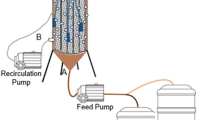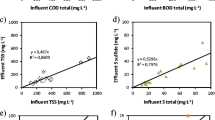Abstract
A pilot-scale sewage treatment system consisting of two upflow anaerobic sludge bed (UASB) reactors followed by five waste stabilization ponds (WSPs) in series was studied under subtropical conditions. The first UASB reactor started up in only 1 mo (stable operation, high chemical oxygen demand [COD] removal efficiency, low volatile fatty acids concentration in the effluent, alkalinity ratio above 0.7, biogas production above 0.1 Nm3/kg of CODremoved). Removal efficiencies up to 90% were obtained in the anaerobic steps at a hydraulic retention time of 6+4h (80% removal in the first step). Fecal coliform removal in the whole system was 99.9999% (99.94% in anaerobic steps and 99.98% in WSPs). COD balances over UASB reactors are provided. A minimum set of data necessary to build COD balances is proposed. Intermittent sludge washout was detected in the reactors with the COD balances. Sludge washout from single-step UASB reactors should be monitored and minimized in order to ensure constant complicance with discharge standards, especially when no posttreatment is provided. The system combined high COD and fecal coliform removal efficiency with an extremely low effluent concentration, complying with discharge standards, and making it an attractive option for sewage treatment in subtropical regions.
Similar content being viewed by others
References
Seghezzo, L., Zeeman, G., van Lier, J. B., Hamelers, H. V. M., and Lettinga, G. (1998), Bioresour. Technol. 65, 175–190.
Elmitwalli, T. A. (2000), PhD thesis, Wageningen University, The Netherlands.
Singh, K. S. and Viraraghavan, T. (2001), in Proceedings of the 9th World Congress on Anaerobic Digestion 2001, Pt. 1, van Velsen, A. F. M. and Verstraete, W. H., eds., Technologisch Institut, Antwerp, Belgium, pp. 493–498.
van Haandel, A. C. and Lettinga, G. (1994), Anaerobic Sewage Treatment: A Practical Guide for Regions with a Hot Climate, John Wiley & Sons, Chichester, England.
Wang, K. (1994), PhD thesis, Wageningen Agricultural University, The Netherlands.
Wiegant, W. M. (2001), in Anaerobic Digestion for Sustainable Development, Papers of the Farewell Seminar of Prof. Dr. Ir. Gatze Lettinga, van Lier, J. and Lexmond, M., eds., Environmental Protection and Resource Conservation Foundation (EPZRC), Wageningen, The Netherlands.
Lettinga, G., Roersma, R., and Grin, P. (1983), Biotechnol. Bioeng. 25, 1701–1723.
de Man, A. W. A., van der Last, A. R. M., and Lettinga, G. (1988), in Proceedings of the 5th International Symposium on Anaerobic Digestion, Hall, E. R. and Hobson, P. N., eds., IAWPRC, Bologna, Italy, pp. 197–208.
Seghezzo, L., Guerra, R. G., González, S. M., Trupiano, A., Figueroa, M. E., Cuevas, C. M., Zeeman, G., and Lettinga, G. (2000), Water Sci. Technol., submitted.
Zakkour, P. D., Gaterell, M. R., Griffin, P., Gochin, R. J., and Lester, J. N. (2001), Water Res. 35, 4137–4149.
Kalogo, Y. (2000), PhD thesis, Gent University, Belgium.
Cavalcanti, P. F. F., van Haandel, A., and Lettinga, G. (2001), Water Sci. Technol. 44(4), 237–245.
Cavalcanti, P. F. F., van Haandel, A., and Lettinga, G. (2002), Water Sci. Technol. 45(1), 75–81.
Liberal, V., Cuevas, C. M., Trupinao, A. P., and Bohuid, E. (1998), in Proceedings of the 26th Interamerican Congress on Sanitary and Environmental Engineering, Lima, Peru (in Spanish).
Arias, M., and Bianchi, A. R. (1996), Estadisticas Climatológicas de la Provincia de Salta, Dirección de Medio Ambiente y Recursos Naturales de la Provincia de Salta, INTA EEA Salta and Gobierno de la Provincia de Salta, eds, Salta: Argentina (in Spanish).
Haskoning and WAU. (1994), Anaerobic Treatment of Domestic Sewage Under Tropical Conditions, DECOM Manual (Design, Construction, Operation and Maintenance of UASB reactors for domestic wastewater), Wageningen Agricultural University, the Netherlands.
DET (Department of Environmental Technology). (1994), Manual of Laboratory Methods and Procedures for Anaerobic Wastewater Treatment, Wageningen Agricultural University, The Netherlands.
APHA, AWWA, and WEF. (1995), Standard Methods for the Examination of Water and Wastewater, 19th ed., Eaton, A. D., Clesceri, L. S., and Greenberg, A. E., eds., American Public Health Association, American Water Works Association, and Water Environment Federation, Washington DC.
Marais, G. V. R. (1974), J. Environ. Eng. Div. 100, EE1, 119.
von Sperling, M. (1996), Princípios do tratamento biológico de águas residuárias. Volume 3, Lagoas de estabilização, Sanitary and Environmental Engineering Department-DESA, Federal University of Minas Gerais, Brazil (in Portuguese).
Noyola Robles, A. (1994), in Proceedings of the 3rd Latin American Workshop and Seminar Anaerobic Wastewater Treatment, Vinãs, M., Soubes, M., Borzacconi, L., and Muxi, L., eds., Universidad de la República, Montevideo, Uruguay (in Spanish).
SeMADeS (Secretary of the Environment and Sustainable Development). (2001), Resolution no. 011, Salta, Argentina (in Spanish).
European Union Council of Ministers. (1991), Off. J. Eur. Comm., 135/40.
Chernicharo, C. A. L., van Haandel, A. C., Cybis, L. F., and Foresti, E. (2001), in Proceedings of the 9th World Congress Anaerobic Digestion 2001, Pt. 1, van Velsen, A. F. M. and Verstraete, W. H., eds., Technologisch Institut, Antwerp, Belgium, pp. 747–752.
WHO (World Health Organisation). (1989), Technical Report Series 778, WHO, Geneva, Switzerland.
Zeeman, G. and Lettinga, G. (1999), Water Sci. Technol. 39(5), 187–194.
Zeeman, G., Sanders, W. and Lettinga, G. (2000), Water Sci. Technol. 41(1), 9–16.
van der Meer, R. R. (1979), PhD thesis, Wageningen Agricultural University, The Netherlands.
Author information
Authors and Affiliations
Corresponding author
Rights and permissions
About this article
Cite this article
Seghezzo, L., Trupiano, A.P., Liberal, V. et al. Two-step upflow anaerobic sludge bed system for sewage treatment under subtropical conditions with posttreatment in waste stabilization ponds. Appl Biochem Biotechnol 109, 167–180 (2003). https://doi.org/10.1385/ABAB:109:1-3:167
Issue Date:
DOI: https://doi.org/10.1385/ABAB:109:1-3:167




